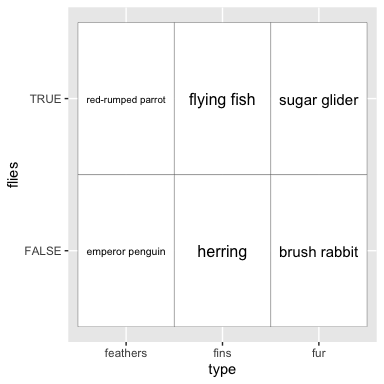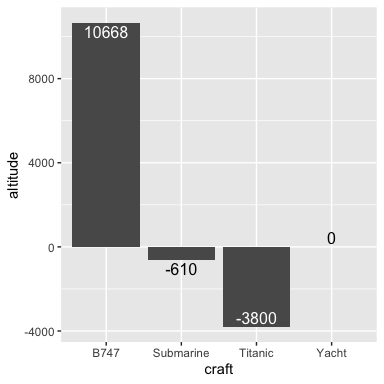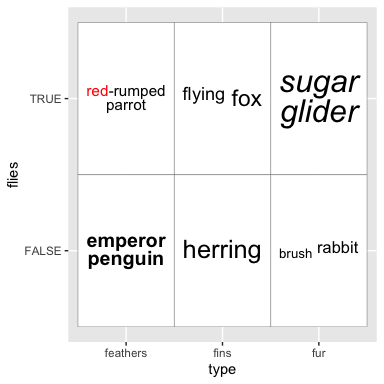
The hardware and bandwidth for this mirror is donated by dogado GmbH, the Webhosting and Full Service-Cloud Provider. Check out our Wordpress Tutorial.
If you wish to report a bug, or if you are interested in having us mirror your free-software or open-source project, please feel free to contact us at mirror[@]dogado.de.
ggfittext is a ggplot2 extension for fitting text into boxes.

Install the release version of ggfittext from CRAN:
install.packages("ggfittext")If you want the development version, install it from GitHub:
devtools::install_github("wilkox/ggfittext")Sometimes you want to draw some text in a ggplot2 plot so that it
fits inside a defined area. You can do this by manually fiddling with
the font size, but this is tedious and un-reproducible. ggfittext
provides a geom called geom_fit_text() that automatically
resizes text to fit inside a box. It works like this:
ggplot(animals, aes(x = type, y = flies, label = animal)) +
geom_tile(fill = "white", colour = "black") +
geom_fit_text()
As with geom_text(), the position of the text is set by
the x and y aesthetics.
geom_fit_text() tries to infer the width and height of the
box in which the text is allowed to fit, and shrinks down any text that
is too big.
Another way to make the text fit in the box is by reflowing it; that
is, wrapping it over multiple lines. With the reflow = TRUE
argument, geom_fit_text() will reflow the text before (if
still necessary) shrinking it:
ggplot(animals, aes(x = type, y = flies, label = animal)) +
geom_tile(fill = "white", colour = "black") +
geom_fit_text(reflow = TRUE)
If you want the text to be as large as possible, the argument
grow = TRUE will increase the text size to the maximum that
will fit in the box. This works well in conjunction with
reflow:
ggplot(animals, aes(x = type, y = flies, label = animal)) +
geom_tile(fill = "white", colour = "black") +
geom_fit_text(reflow = TRUE, grow = TRUE)
By default, text is placed in the centre of the box. However, you can
place it in a corner or on a side of the box with the place
argument, which takes values like “top”, “topright”, “bottomleft” and so
on:
ggplot(animals, aes(x = type, y = flies, label = animal)) +
geom_tile(fill = "white", colour = "black") +
geom_fit_text(place = "topleft", reflow = TRUE)
ggfittext also provides a geom geom_bar_text() for
labelling bars in bar plots:
ggplot(altitudes, aes(x = craft, y = altitude, label = altitude)) +
geom_col() +
geom_bar_text()
geom_bar_text() works with stacked bar plots:
ggplot(beverages, aes(x = beverage, y = proportion, label = ingredient,
fill = ingredient)) +
geom_col(position = "stack") +
geom_bar_text(position = "stack", reflow = TRUE)
And it works with dodged bar plots, and with flipped bar plots:
ggplot(beverages, aes(x = beverage, y = proportion, label = ingredient,
fill = ingredient)) +
geom_col(position = "dodge") +
geom_bar_text(position = "dodge", grow = TRUE, reflow = TRUE,
place = "left") +
coord_flip()
With the rich = TRUE argument,
geom_fit_text() and geom_bar_text() both
support a limited subset of Markdown and HTML markup for text (rendered
with gridtext).
ggplot(animals_rich, aes(x = type, y = flies, label = animal)) +
geom_tile(fill = "white", colour = "black") +
geom_fit_text(reflow = TRUE, grow = TRUE, rich = TRUE)
Rich text cannot be drawn in polar coordinates. Please note that this feature is liable to change, and is subject to upstream changes to gridtext.
If you want to manually set the limits of the box (instead of having
them inferred from x and y), you can use
xmin & xmax and/or ymin &
ymax:
ggplot(presidential, aes(ymin = start, ymax = end, x = party, label = name)) +
geom_fit_text(grow = TRUE) +
geom_errorbar(alpha = 0.5)
Alternatively, you can set the width and/or height with the
width and/or height arguments, which should be
grid::unit() objects. The horizontal and/or vertical centre
of the box will be defined by x and/or y.
Text can be drawn in polar coordinates with
geom_fit_text() simply by adding coord_polar()
to the plot. This feature is experimental and any bug reports are very
welcome.
p <- ggplot(gold, aes(xmin = xmin, xmax = xmax, ymin = ymin, ymax = ymax,
fill = linenumber, label = line)) +
coord_polar() +
geom_rect() +
scale_fill_gradient(low = "#fee391", high = "#238443")
p + geom_fit_text(min.size = 0, grow = TRUE)
When text is drawn in polar coordinates, the flip = TRUE
argument can be used to flip upside-down text the ‘right way up’ to ease
readability:
p + geom_fit_text(min.size = 0, grow = TRUE, flip = TRUE)
All arguments to geom_fit_text() can also be used with
geom_bar_text().
contrast can be used to automatically
invert the colour of the text so it contrasts against a background
fill:ggplot(animals, aes(x = type, y = flies, fill = mass, label = animal)) +
geom_tile() +
geom_fit_text(reflow = TRUE, grow = TRUE, contrast = TRUE)
padding.x and
padding.y can be used to set the padding
between the text and the edge of the box. By default this is 1 mm. These
values must be given as grid::unit() objects.min.size sets the minimum font size in
points, by default 4 pt. Text smaller than this will be hidden (see also
outside).outside is FALSE by
default for geom_fit_text(). If TRUE, text
that is placed at “top”, “bottom”, “left” or “right” and must be shrunk
smaller than min.size to fit in the box will be flipped to
the outside of the box (if it fits there). This is mostly useful for
drawing text inside bars in a bar plot.hjust and
vjust set the horizontal and vertical
justification of the text, scaled between 0 (left/bottom) and 1
(right/top). These are both 0.5 by default.formatter allows you to provide a
function that will be applied to the text before it is drawn. This is
mostly useful in contexts where variables may be interpolated, such as
when using gganimate.fullheight is automatically set
depending on place, but can be overridden with this option. This is used
to determine the bounding box around the text. If FALSE,
the bounding box includes the x-height of the text and ascenders, but
not any descenders. If TRUE, it extends from the top of the ascenders to
the bottom of the descenders. This is mostly useful in situations where
you want to ensure the baseline of text is consistent between labels
(fullheight = FALSE), or when you want to avoid descenders
spilling out of the bounding box (fullheight = TRUE).

These binaries (installable software) and packages are in development.
They may not be fully stable and should be used with caution. We make no claims about them.
Health stats visible at Monitor.